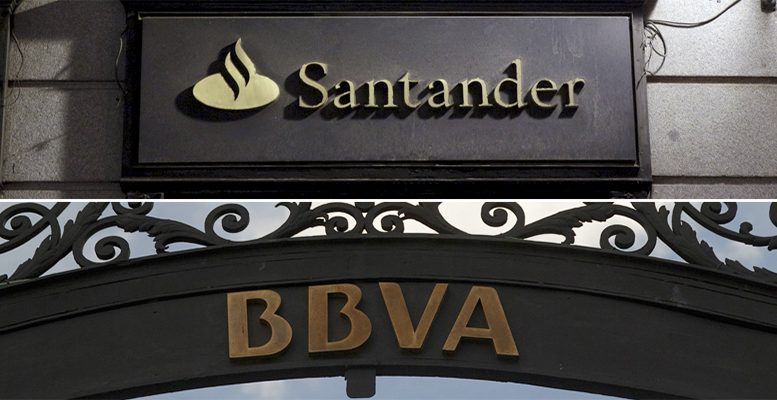Mari Pinardo | Banco Santander announced earlier this week that it posted profits of 6.6 billion euros in 2017, up 7% from a year earlier: BBVA published its results yesterday, with profits rising 1.3% year-on-year to 3.5 billion. Ten years after the global financial crisis neither of the two banks has recovered their level of earnings and their market capitalisation is far off what it was. So is the crisis really over for Spain’s two biggest financial institutions?
In its fourth quarter financial report, Banco Santander said assets totalled 1.444 billion euros; at end-2007, it had assets of 912.9 billion. Net profit has dropped by 27% over these last 10 years: at end-2007, it posted profits of 9.060 billion euros compared with the 6.6 billion recorded in 2017.
BBVA’s total assets stood at 690.059 billion euros at end-2017, while 10 years earlier they totalled 502 billion. In terms of profits, the bank has lost 43% over the decade, from the 6.1 billion posted in 2007 to the 3.5 reported for 2017. And in the stock market…Banco Santander has increased its market capitalisation by 5.2 billion euros or 5.7% in 10 years; BBVA has seen its market value drop by 11.912 billion euros or 19% over the same period. Neither of the banks has recovered its 2007 level of market capitalisation.
At the end of December 2007, months before the stock markets collapsed in the wake of Lehman Brothers’ demise, Banco Santander’s market capitalisation was 92.501 billion euros – according to Consenso del Mercado figures -; at last Friday’s close, according to figures from Bankinter, the bank presided over by Ana Botin had a market value of 97.7 billion euros. This is only 5.23 billion euros more than its pre-crisis market value for the lender which took over Banesto and more recently Banco Popular. And the recovery has happened this very month thanks to the recovery in the banks’ share price.
In December, Banco Santander still had a market value below that of 2007 – 88.4 billion euros. Neither have its shares recovered their 2007 value. The first has recovered its market capitalisation “by the skin of its teeth”, the second is still a long way from achieving it.
In 10 years, they have fallen 9,32 euros. In December 2007, Santander’s shares traded at 14,79 euros each, while at end-2017 they traded at 5,47 euros each. It’s true, however, that the bank has carried out capital hikes which means that it has 16,136,154 million shares currently compared with 6,254,297 million at end-2007. Its PER has gone from 15,48x to 12,64x in 10 years – according to Bloomberg -, below the 15x which consensus usually considers as favourable for this ratio.
Neither can BBVA, the second biggest Spanish bank after Banco Santander, be sure that its shares have recovered from the crisis based on its figures. In 2007, the lender had a market capitalisation of 62.8 billion euros, while it now has 50.9 billion, according to figures from last Friday.
Over the last 10 years, BBVA’s market value has declined 11.9 billion euros or 19%. As far as its stock price goes, it has continued to fall since 2007. In total, the Basque lender’s shares have lost 9,65 euros since 2007 when it was trading at 16.76 euros by year-end. At end-2017, the share price was practically the half: 7,11 euros. The number of shares has risen to 2,919.918 over the ten years. In terms of BBVA’s PER, this was 9,86x in 2007 and rose to 11,17x in 2017, according to Bloomberg. This means that the stock is more expensive than before as a result of the decline in profits.





